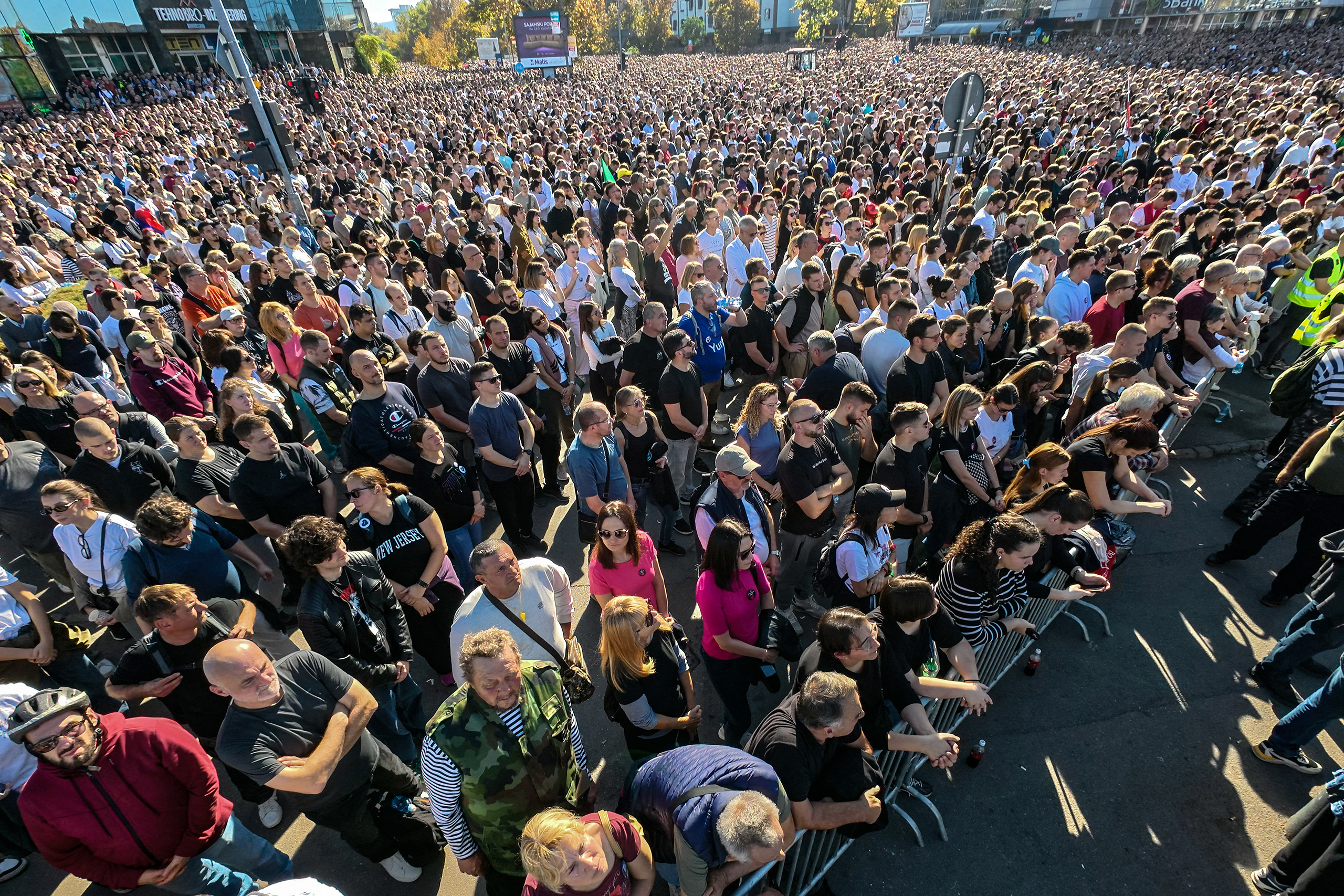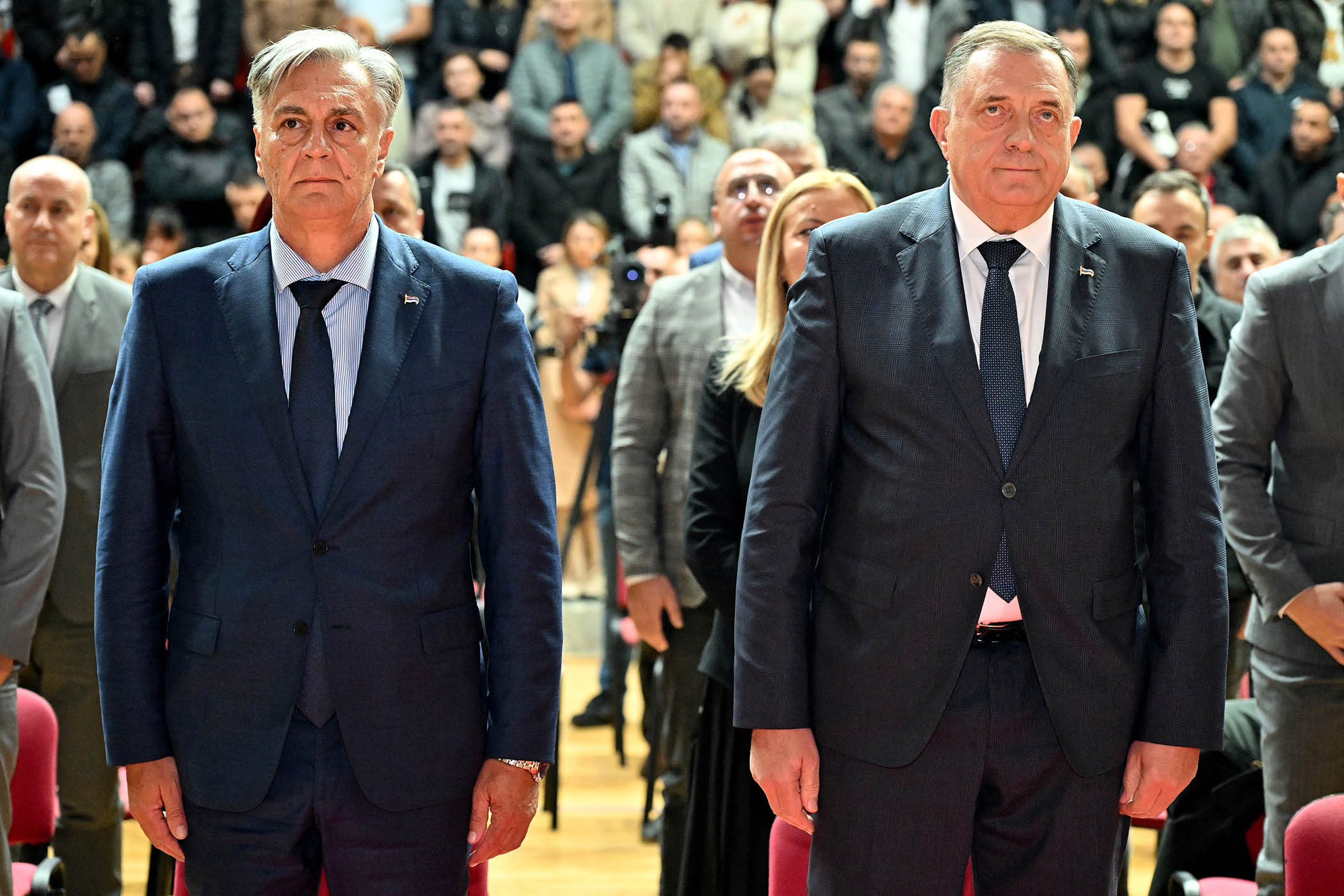Novi Sad railway station was supposed to welcome high-speed trains from Belgrade and Budapest, signalling a prosperous and well-connected future for Serbia. Instead, it has become a symbol for everything that is wrong in the country.
It was an infrastructure project that turned deadly when a concrete canopy collapsed on 1 November last year, killing 16 people who were beneath it. The tragedy sparked the ongoing student-led anti-corruption protest movement that has staged several enormous rallies in Belgrade and this weekend organised a mass commemoration in Novi Sad.
Tens of thousands of people travelled to Serbia’s second city to remember the dead and express their anger about the corruption they hold responsible for the disaster. As well as paying their respects, they called for an end to the domination of the country by President Aleksandar Vučić and his governing Serbian Progressive Party (SNS).
They could not have come by train even if they had wanted to. All services to Novi Sad were cancelled, supposedly due to bomb threats – though opponents of the government suspected the authorities were simply trying to suppress the turnout.
The protesters were undeterred. On Friday evening, thousands of people lined the streets of Novi Sad to cheer arrivals coming in by foot and bicycle. They beat drums, blew vuvuzelas and lit flares as if to light the way for their weekend guests. Entire families turned out for the occasion, hoisting the smallest children on to shoulders or ushering them to the front of the crowd, where student stewards made space for them.
Related articles:
The arrivals had made their way from around the country, from Nis and Novi Pazar in the south to Subotica in the north, with many congregating in the capital before travelling on to Novi Sad.
In many ways it was a joyous gathering. But there was a deep vein of anger beneath the cheers, with participants determined both to commemorate the dead and to bring meaningful change to Serbia.
We can’t live in a corrupt system. Things need to change – and everyone needs to do their part
Aleksandra, a 24-year-old student
“What I expect is for even more people to wake up,” said Aleksandra, a 24-year-old student of applied electronics at Novi Sad university, who did not want to give her surname. “We can’t live in a corrupt system. Things need to change – and everyone needs to do their part.”
The protesters have certainly been doing that. The massive rallies in Belgrade in December, March and July grabbed the headlines as the biggest demonstrations since Serbia became democratic in 2001. But smaller protests around the country have also played an important role in maintaining the momentum.
Initially, the movement’s demands were for full accountability and transparency about the railway station project. Vučić eventually responded by dispensing with his prime minister, Milos Vučević, but the protesters viewed that as little more than a sop. They are now demanding fresh elections, with the goal of removing the SNS from power.
Many Serbians cannot forget or forgive President Vučić’s past as a minister under the ruinous rule of Slobodan Milošević
Protests have been a regular occurrence since the party formed its first government in 2012. Many Serbians cannot forget or forgive President Vučić’s past as a minister under the ruinous rule of Slobodan Milošević in the 1990s. They remain unconvinced by his ostensible pivot away from Serbian ultranationalism and towards EU membership, and complain that the SNS dominates national institutions and media coverage, perpetuating its grip on power.
But in the absence of a compelling opposition proposition, Serbians have kept on electing Vučić and the SNS – and successive protest movements have fizzled out. The current movement, however, has demonstrated unusual staying power.
“I’m genuinely surprised by the length and intensity of the movement,” says Magda Anastasijevic, the Eastern Europe research manager for the US-based conflict monitor, ACLED. “Students are a new actor – and their marches have been a way of raising awareness for people who don’t have access to independent information through the media. The government’s reactions have galvanised and sustained the movement.”
Indeed, ACLED data suggests that violent “interventions” by the authorities have doubled since June. Far from scaring off the students, it only appears to have ramped up their efforts to ensure that the power structure they hold responsible for the Novi Sad disaster is removed. They are proposing to enter a list of expert, independent candidates in the next election – whenever it is held – to serve as a technocratic government which would tackle corruption and clientelism.
Perhaps it is Vučić who has taken fright. On the eve of the commemoration, he made a televised address to the nation, apologising for his conduct over the past year and calling for a more constructive approach. “I invite those who are protesting to come, to express their wishes, and participate in the conversation,” he said. “Not through ultimatums, but through dialogue.”
That sentiment has failed to move the protesters. They turned out in huge numbers for the anniversary gathering in front of Novi Sad railway station, this time observing 16 minutes of commemorative silence rather than shouting in anger. And the student protest leaders insist they are far from finished.
“Our movement is righteous, truthful and honest,” Aleksandra said. “Older Serbians might have made peace with their situation – but we’re thinking about future generations.”
Photographs by Andrej Isakovic/AFP via Getty Images


